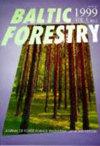EEcosystem fit of Scots pine (Pinus sylvestris L.) plantations in south-western Bulgaria
IF 0.6
4区 农林科学
Q3 FORESTRY
引用次数: 0
Abstract
А classification according to the level of ecosystem fit for plantations of Scots pine in south-western Bulgaria is proposed in this study. For this purpose, two indices which characterize the relief and soil conditions are used. The assessment of climatic conditions is made using the De Martonne index. The plantations are classified into four groups and two subgroups. The predominant part (55.8%) of the studied plantations grows in highly vulnerable to drought zone, while 35.5% are in the absence of ecosystem fit. This way of classification of the Scots pine plantations will allow to apply differentiated management regimes. In the present conditions of climate change, this classification can be used in estimation of the appropriate habitats for the afforestation by establishing Scots pine plantations in the future. Keywords: adaptive management, climate change, aridity index, forest stands classification保加利亚西南部苏格兰松人工林生态系统的适宜性
本文提出了保加利亚西南部苏格兰松人工林生态系统适宜度的А分类方法。为此,使用了表征地形和土壤条件的两个指标。气候条件的评估是使用德马尔顿指数进行的。人工林可分为四类和两亚类。55.8%的人工林生长在干旱易感区,35.5%的人工林生长在干旱不适宜区。这种对苏格兰松种植园的分类方式将允许应用差异化的管理制度。在当前气候变化条件下,该分类可用于估算未来建立苏格兰松人工林的适宜造林生境。关键词:适应性经营,气候变化,干旱指数,林分分类
本文章由计算机程序翻译,如有差异,请以英文原文为准。
求助全文
约1分钟内获得全文
求助全文
来源期刊

Baltic Forestry
农林科学-林学
CiteScore
1.60
自引率
0.00%
发文量
23
审稿时长
>12 weeks
期刊介绍:
The journal welcomes the original articles as well as short reports, review papers on forestry and forest science throughout the Baltic Sea region and elsewhere in the area of boreal and temperate forests. The Baltic Sea region is rather unique through its intrinsic environment and distinguished geographical and social conditions. A temperate climate, transitional and continental, has influenced formation of the mixed coniferous and deciduous stands of high productivity and biological diversity. The forest science has been affected by the ideas from both the East and West.
In 1995, Forest Research Institutes and Universities from Estonia, Latvia and Lithuania
joined their efforts to publish BALTIC FORESTRY.
 求助内容:
求助内容: 应助结果提醒方式:
应助结果提醒方式:


